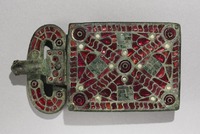Visigothic belt buckles
Type:
Belt buckles
Date:
ca. 525–60
Location or Findspot (Modern-Day Country):
Spain
Medium:
Bronze,
Glass,
Garnet,
Mother of pearl,
Gold
Dimensions:
Ranging from 7 to 14 cm in length
Description:
These belt buckles are associated with the Visigoths, a Germanic tribe that settled in the Iberian Peninsula beginning in the sixth century. The Visigoths had their capital at Toledo and were the dominant kingdom until 711, when they were defeated by an invading force of Arabs and Berbers. Visigothic items of personal adornment have been excavated from cemeteries across modern-day Spain and Portugal. The belt buckles are generally made of bronze with inlaid colored glass, and sometimes semi-precious stones. This cloisonné technique was also used for used for contemporary fibulae. The more luxurious, brightly colored example reproduced here also incorporates garnets, mother of pearl, gold foil, and traces of gilding. They no doubt indicate the wealth and status of the individuals with whom they were buried, many of whom were women.
Relevant Textbook Chapter(s):
3
Repository and Online Resources:
• Read more about these belt buckles on the website of the Cleveland Museum of Art.



